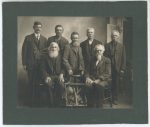
On April 26, 2018, The National Memorial for Peace and Justice opened in Montgomery, Alabama. The memorial, which was erected by the Equal Justice Initiative, is also informally known as the National Lynching Memorial. According to EJI’s website, this “is the nation’s first memorial dedicated to the legacy of enslaved black people, people terrorized by lynching, African Americans humiliated by racial segregation and Jim Crow, and people of color burdened with contemporary presumptions of guilt and police violence.” (https://eji.org/national-lynching-memorial)
When I heard about the memorial’s recent opening, I was reminded of a lynching that occurred in Morrison County, Minnesota.
On Monday, August 17, 1857, three men, two of whom were Native Americans, one of whom was Métis, were lynched by citizens of Swan River while they were being transported by the sheriff to be prosecuted in St. Paul for a murder.
The story was reported in the Sauk Rapids, MN, newspaper The Frontiersman on August 20, 1857, with the article being picked up and published by the New York Times. It was later recounted by Nathan Richardson in his 1876 and 1880 histories of Morrison County and again in a book published in 1904 called Enmegahbowh’s Story. Richardson and Enmegahbowh were both involved in events related to the lynching so were able to provide further details.
Enmegahbowh was told by a Native woman that she had witnessed an attack on a man by the three young men, whose names were Charles Gigabish, James, and Jo Shambo. She saw them rob the man, who was a German pack peddler by the name of Fritz, and drag him to Round Lake near Crow Wing, thinking they intended to drown him.
Enmegahbowh went with the woman to the area and they searched until they found the body buried in a shallow grave. Enmegahbowh returned home and found the three young men in his house. With the help of three other men who were at his house, including Charles Selkrig, they managed to arrest the men and take them to Morrison County Sheriff Jonathan Pugh.
Pugh started his journey to St. Paul with the men to have them tried.
“He was overtaken, when about ten miles from Little Falls, by a party of men from Swan River, headed by Anson Northup, who took the indians [sic] from the sheriff and brought them back as far as Swan River, where, upon examination, they confessed they had committed the crime. They were accordingly taken the same evening, about half way to Little Falls, and all three were hanged by the road side, at the south edge of Little Falls Prairie, on a pole laid in the forks of two oak trees. They were left hanging until the next day at about 10 o’clock, when a crowd of people assembled and took them down. A grave was dug near the roots of the trees on which they were hanged, and all three were put in the same hole.” (A Big Hearted Paleface Man, pg. 169-170)
The current day location where the hanging took place is at the site of the Little Falls Golf Course.
In June 1901, the bones of the lynched men were dug up, with Nathan Richardson being present among the crowd of people who were there “to get relics from the remains.” (LFDT, June 3, 1901) The bones were found with the shackles the men had worn when they were lynched. The remains were split up among those in the crowd, with Richardson ending up with a wooden box of bones, including the shackles, that he kept in his office in the Historic Courthouse to show visitors.
That box eventually made its way into the Morrison County Historical Society collection in its basement space in the courthouse. Because the space was not as secure between 1938 and the early 1970s (when MCHS made its home there) as it is now, the box of bones disappeared.
If the bones had still been in the MCHS collection in 1990, the year the Native American Graves Protection and Repatriation Act (NAGPRA) became law, they would have been returned to the Ojibwe for repatriation. As it stands, the location of the bones is an open question. They could be tucked away on someone’s property, with the current owners having no idea of their provenance.
If you have a box with human remains and shackles that matches the one in the photo, or you are aware of someone who does, we’d be interested in hearing from you. MCHS can assist in returning the remains to the tribe. Please give the Weyerhaeuser Museum a call at 320-632-4007.
~ Mary Warner
Executive Director
Sources:
Equal Justice Initiative, The National Memorial for Peace and Justice, https://eji.org/national-lynching-memorial
“Horrible Tragedy,” The Frontiersman, Sauk Rapids, MN, August 20, 1857.
“Two Indians and Half-Breed Lynched in Minnesota, The New York Times, October 7, 1857.
“En-me-gah-bowh’s Story: An Account of the Disturbances of the Chippewa Indians at Gull Lake in 1857 and 1862 and their Removal in 1868,” Woman’s Auxiliary, St. Barnabas Hospital, Minneapolis, MN, 1904.
Warner, Mary, “A Big Hearted Paleface Man: Nathan Richardson and the History of Morrison County, MN,” Morrison County Historical Society, 2006.
“Unearthed the Indians,” Little Falls Daily Transcript, Little Falls, MN, June 3, 1901.
Native American Graves Protection and Repatriation Act website: https://www.nps.gov/nagpra/
This article originally appeared in the Morrison County Historical Society newsletter, Vol. 31, No. 2, 2018.

